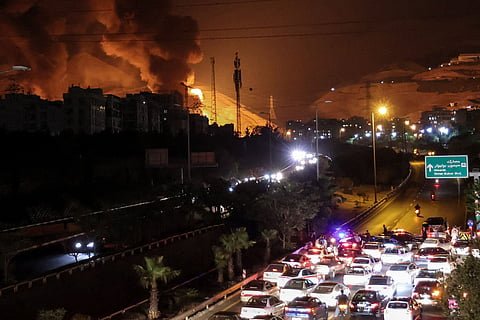Israel–Iran conflict latest: 10 key updates you need to know
From targeted strikes to civilian evacuations, here’s what’s unfolding in the standoff

Dubai: Hostilities between Israel and Iran have intensified on Day 4 on Monday (June 16), marking a sharp escalation in an already tense regional relationship.
The latest round of attacks and counterattacks has resulted in significant casualties, damage to infrastructure, and growing international concern.
Both nations have made strong public statements and the conflict is drawing in wider attention as global powers call for restraint.
Here are 10 key developments that explain the current situation:
Iran launches a new wave of missile strikes
In the early hours of Monday, Iran fired another volley of missiles toward Israel. The attack triggered air raid sirens across several Israeli cities, forcing residents to take cover. It marked the fourth consecutive day of open military exchanges between the two countries.
Israeli emergency services confirmed that five people were killed and dozens more injured in the Monday attacks. The damage spanned both urban and residential areas, adding to public anxiety and pressure on civil infrastructure.
Missile lands near US consulate in Tel Aviv
One missile reportedly landed near the US consulate in Tel Aviv, causing minor damage. US Ambassador Mike Huckabee confirmed that no American personnel were injured. The proximity of the strike raised concerns about potential international spillover.
Tehran announced that it had launched around 100 missiles, describing the strikes as retaliation for Israeli attacks on its military and nuclear infrastructure. Iranian officials vowed further action if Israel continues its offensive.
Israel reports facing over 370 Iranian missiles and drones
According to the Israeli military, Iran has fired more than 370 missiles and sent hundreds of drones toward Israeli territory since Friday. Israel’s air defence systems have intercepted many of these, though several have caused significant damage.
Israeli jets strike Quds Force command centers
In response, Israeli fighter jets targeted 10 command centers belonging to the Quds Force — a key arm of Iran’s Revolutionary Guard responsible for foreign operations. The Israeli military stated that these sites were used to coordinate attacks against Israel.
Iranian missiles hit Tel Aviv and Petah Tikva
Multiple Iranian missiles struck central Israel, including residential areas in Tel Aviv and Petah Tikva. In Petah Tikva, a missile hit an apartment block, causing severe damage to several floors. Emergency crews were seen pulling people from the rubble.
Iran’s Revolutionary Guard warned that future strikes could be “more severe, precise, and destructive.” This followed a statement by Iran’s foreign minister offering to stop attacks if Israel also halted its strikes — a proposal that appears to have failed.
Civilian casualties rising on both sides
Iranian authorities report that 1,277 people have been injured since Friday, including many civilians. Israel says at least 24 Israelis have been killed and more than 500 wounded, highlighting the human cost on both sides.
Top Iranian military and nuclear figures killed
Among those killed in Israel’s initial strikes were senior Iranian military leaders, including Major General Mohammad Bagheri and IRGC commander Hossein Salami. Several Iranian nuclear scientists were also reported killed, dealing a blow to Iran’s security and research infrastructure.
Israel targets nuclear and military infrastructure
Israeli airstrikes hit over 100 targets in Iran on Friday, including the Natanz nuclear facility and other key military installations. While some nuclear sites sustained damage, the fuel enrichment plant at Natanz remained intact according to satellite imagery
Oil refineries and power plants also struck
Israel’s attacks expanded to include energy infrastructure. Fuel depots around Tehran were hit, and a power plant in Haifa was seen burning after a missile strike. The Israeli Electric Corporation also reported damage to central Israel’s power grid.
Tehran warned that any military support from the US, UK, or France in intercepting Iranian missiles would make their bases and naval assets legitimate targets. While the US confirmed helping Israel intercept missiles, it said it was not part of the initial Israeli strikes.
Panic in Tehran and fuel shortages reported
Widespread fear has gripped Iran’s capital. Long lines formed at petrol stations as residents attempted to flee Tehran. With limited access to shelters, many are trying to relocate to more remote areas, such as the Caspian Sea region.
Diplomatic efforts have stalled. A planned round of US–Iran nuclear talks was cancelled, and Iran informed Qatar and Oman that it would not enter ceasefire negotiations while under Israeli attack. Meanwhile, Israeli leadership has justified the strikes as a necessary preemptive action.
Sign up for the Daily Briefing
Get the latest news and updates straight to your inbox




